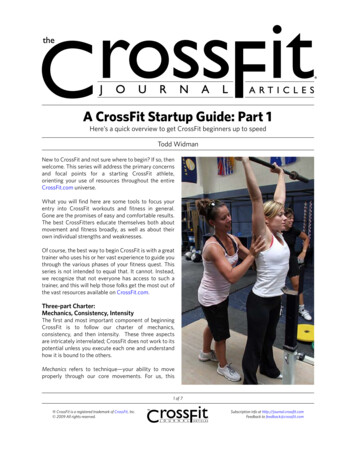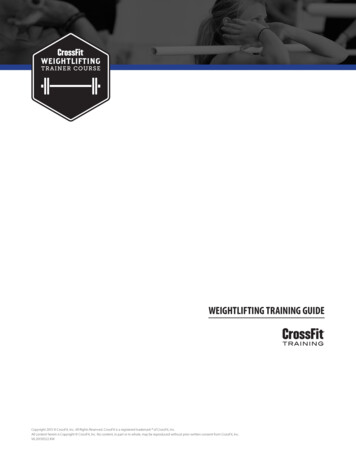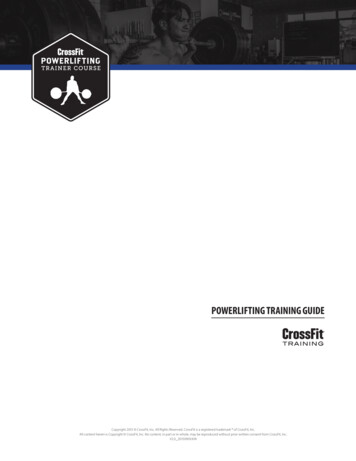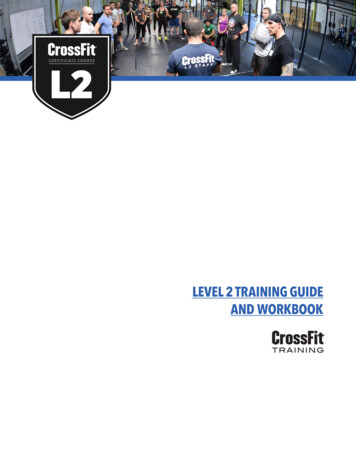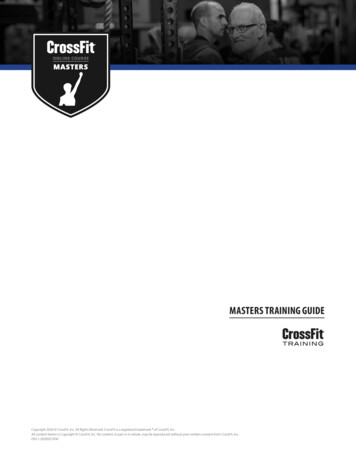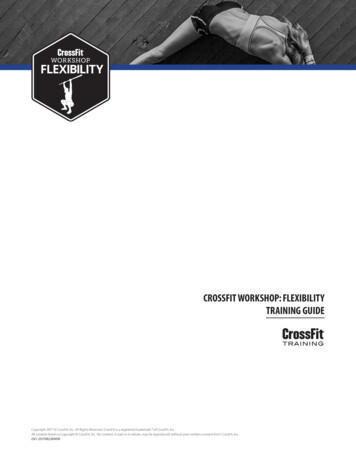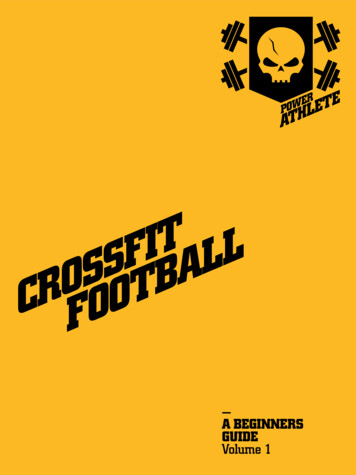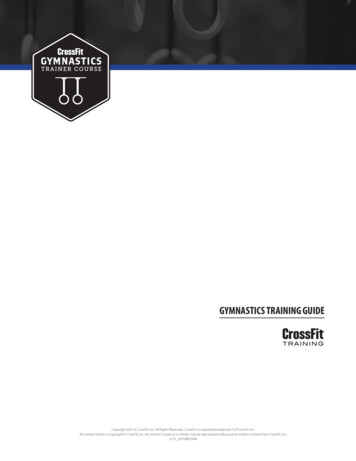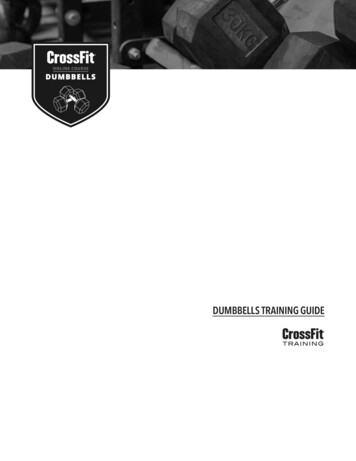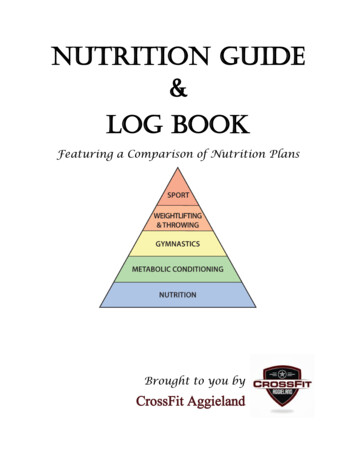
Transcription
Nutrition Guide&Log bookFeaturing a Comparison of Nutrition PlansBrought to you byCrossFit Aggieland
One size does not fit allNutrition only works if you stick with it. We all have times in life when we have strayedaway from following a healthy diet; life challenges can take priority and clean eating fallto the wayside. It happens. And while there are times we need to crack down on our diet,we do not encourage quick-fix “dieting.” Instead, we want to help you find a nutritionsystem and plan to fit your lifestyle as a long-term solution. After all, it is much easier tolock in to a nutrition system that fits your lifestyle and personality, rather than fightingyourself with a short-term “diet.”Nutrition in and of itself should not be hard. When nutrition becomes easy for you, youwill find the results you desire also come easy. However, modifying your nutrition to findwhat works best for you can be challenging.This Nutrition Guide offers many of the popular programs designed to help you getcontrol of your personal nutrition. There is no one “right” program, and what works bestfor one person might not work best for you. We encourage you to read each of thedifferent programs and see first which one seems most manageable within your currentlifestyle. If it seems overwhelming or too difficult, you will not stick with it. Rememberthat this booklet is only a snapshot of each program. You can research further online,finding all kinds of information, grocery lists, recipes, and more.After you select the program you think will work best for you and your lifestyle, discussit with your coach. Identify potential pitfalls for you and tips to find success. Encourageyour group to hold one another accountable, and utilize the food log at the back of thisbooklet to track your nutrition.Just like there is no such thing as “one size fits all,” there is also no such thing as onenutrition plan fits all. In fact, you might find that various aspects from multiple nutritionplans work for you! Be flexible and willing to adjust to figure out what is the idealnutrition system for you. Keep at it until you achieve the results you desire, and nutritionis integrated into your lifestyle. It can be challenging at first, but once you know whatworks for you, the rest is a piece of cake.
Whole30Yes: Eat real food.Eat meat, seafood, eggs, tons of vegetables, some fruit, and plenty of good fats fromfruits, oils, nuts and seeds. Eat foods with very few ingredients, all pronounceableingredients, or better yet, no ingredients listed at all because they’re totally natural andunprocessed. Don’t worry these guidelines are outlined in extensive detail in our freeshopping list.No: Avoid for 30 days.More importantly, here’s what NOT to eat during the duration of your Whole30 program.Omitting all of these foods and beverages will help you regain your healthy metabolism,reduce systemic inflammation, and help you discover how these foods are truly impactingyour health, fitness and quality of life. Do not consume added sugar ofany kind, real or artificial.No maple syrup, honey,agave nectar, coconut sugar,Splenda, Equal, Nutrasweet,Xylitol, Stevia, etc. Readyour labels, becausecompanies sneak sugar intoproducts in ways you mightnot recognize. Do not consume alcohol in anyform, not even for cooking.(And it should go withoutsaying, but no tobaccoproducts of any sort, either.) Do not eat grains. This includes(but is not limited to) wheat,rye, barley, oats, corn, rice,millet, bulgur, sorghum,amaranth, buckwheat,sprouted grains and all ofthose gluten-free pseudograins like quinoa. This alsoincludes all the ways we add
wheat, corn and rice into our foods in the form of bran, germ, starch and so on.Again, read your labels.Do not eat legumes. This includes beans of all kinds (black, red, pinto, navy, white,kidney, lima, fava, etc.), peas, chickpeas, lentils, and peanuts. No peanut butter,either. This also includes all forms of soy – soy sauce, miso, tofu, tempeh,edamame, and all the ways we sneak soy into foods (like lecithin).Do not eat dairy. This includes cow, goat or sheep’s milk products such as cream,cheese (hard or soft), kefir, yogurt (even Greek), and sour cream with theexception of clarified butter or ghee. (See below for details.)Do not consume carrageenan, MSG or sulfites. If these ingredients appear in anyform on the label of your processed food or beverage, it’s out for the Whole30.Do not try to re-create bakedgoods, junk foods, ortreats* with “approved”ingredients. Continuingto eat your old, unhealthyfoods made with Whole30ingredients is totallymissing the point, and willtank your results fasterthan you can say “PaleoPop-Tarts.” Remember,these are the same foodsthat got you into healthtrouble in the first place—and a pancake is still a pancake, regardless of theingredients.These foods are exceptions to the rule, and are allowed during your Whole30. Clarified Butter or Ghee. Clarified butter or ghee is the only source of dairy allowedduring your Whole30. Plain old butter is NOT allowed, as the milk proteins foundin non-clarified butter could impact the results of your program. Refer to ourButter Manifesto for more details on the milk proteins found in butter, purchasinghigh quality butter, and how to clarify it yourself. Fruit juice as a sweetener. Some products or recipes will include fruit as a sweetener,which is fine for the purposes of the Whole30. (We have to draw the linesomewhere.)
Certain legumes. We’re fine with green beans, sugar snap peas and snow peas. Whilethey’re technically a legume, these are far more “pod” than “bean,” and green plantmatter is generally good for you. Vinegar. Most forms of vinegar, including white, balsamic, apple cider, red wine, andrice, are allowed during your Whole30 program. The only exceptions are vinegarswith added sugar, or malt vinegar, which generally contains gluten. Salt. Did you know that all iodized table salt contains sugar? Sugar (often in the formof dextrose) is chemically essential to keep the potassium iodide from oxidizingand being lost. Because all restaurant and pre-packaged foods contain salt, we’remaking salt an exception to our “no added sugar” rule.Good Eating Habits Make your plate 50% fruits and vegetables.Drink lots of water.Eat three meals. No snacks.Eat breakfast before you have coffee.Limit processed foods. Bonus points for omitting it completely.Limit added sugars. Bonus points for omitting it completely.Limit alcohol. Bonus points for omitting it completely.Daily exercise.
Primal DietThis is the basic description of everything our ancestors ate to get the protein, fats,carbohydrates, vitamins, minerals, antioxidants, phenols, fiber, water and other nutrientsnecessary to sustain life. But it was a huge list of individual foods – some anthropologistssay it may have been 200 or 300 food choices at a time depending upon the geographicarea. The net result was a dietary “breakdown” of fat, protein and carbohydrate that wasfar different from what Conventional Wisdom considers optimum today. This dietprovided all the necessary fuel and building blocks that, along with specific exercise,prompted their genes to create strong muscles, enabled them to expend lots of energyeach day moving about, to maintain healthy immune systems, to evolve larger brains andto raise healthy children. They ate sporadically, too. When food was plentiful, they atemore than they needed, and stored the excess as fat. When times were scarce, theysurvived on fat stores. This random or “non-linear” eating pattern kept their bodies in aconstant state of preparedness.
Carbohydrate intake is often the decisive factor in weight loss success and prevention ofwidespread health problems like Metabolic Syndrome, obesity and type 2 diabetes. Theseaverage daily intake levels assume that you are also getting sufficient protein and healthyfats, and are doing some amount of primal exercise. The ranges in each zone account forindividual metabolic differences. 0-50 grams per day: Ketosis and I.F. (Intermittent Fasting) Zone. Excellent catalystfor rapid fat loss through I.F. Not recommended for prolonged periods (except inmedically supervised programs for obese or Type 2 diabetics) due to unnecessarydeprivation of plant foods. 50-100 grams per day: Sweet Spot for Weight Loss. Steadily drop excess body fat byminimizing insulin production. Enables 1-2 pounds per week of fat loss withsatisfying, minimally restrictive meals. 100-150 grams per day: Primal Maintenance Zone. Once you’ve arrived at yourgoal or ideal body composition, you can maintain it quite easily here whileenjoying abundant vegetables, fruits and other Primal foods. 150-300 grams a day: Insidious Weight Gain Zone. Most health conscious eaters andunsuccessful dieters end up here, due to frequent intake of sugar and grain products(breads, pastas, cereals, rice, potatoes – even whole grains). Despite trying to “dothe right thing” (minimize fat, cut calories), people can still gain an average of 1.5pounds of fat every year for decades. 300 grams a day: Danger Zone of the Average American Diet. All but the mostextreme exercisers will tend to produce excessive insulin and store excessive fatover the years at this intake level. Increases risk for obesity, Metabolic Syndromeand type 2 diabetes.
General Guidelines80% of body composition success isdetermined by diet. Limit processedcarb intake (hence, insulinproduction), and obtain sufficientprotein and fat to fuel and rebuild. Protein: Average .7 – 1 gram perpound of lean body mass/day– depending on activitylevels. At times, eating moreprotein than average isacceptable. Carbs: 50-100 grams/day (or less) accelerated fat loss. 100150 grams/day effortlessweight maintenance. Heavyexercisers can increase carbintake as needed to replace glycogen stores. Fat: Enjoy freely, but sensibly, for balance of caloric needs and high dietarysatisfaction levels. Avoid Poisonous Things: Conventional wisdom’s dietary guidelines promote fatstorage, type 2 diabetes, inflammation and obesity! Eliminate: Sugary foods and beverages, grains (wheat, corn, rice, pasta, breads,cereals, etc.), legumes (soy and other beans), trans and partially hydrogenated fats,high-risk conventional meat and produce, and excess PUFA’s (instead, increaseomega-3 oils). Modern Adjustments: Some modern foods that Grok didn’t eat can still be included ina healthy diet. Moderation: Certain high glycemic fruit, coffee, high-fat dairy products, starchy tubervegetables, and wild rice. Supplements: Multivitamin/mineral formula, probiotics, omega-3 fish oil, and proteinpowder. Herbs, Spices and Extracts: Offer many health benefits and enhance enjoyment ofmeals. Sensible indulgences: Dark chocolate, moderate alcohol, high-fat treatsReference: Marks Daily Apple, “How to succeed with the primal blueprint”
South Beach DietThe South Beach Diet, which is named after a glamorous area of Miami, is sometimescalled a modified low-carbohydrate diet. The South Beach Diet is lower in carbs(carbohydrates) and higher in protein and healthy fats than is a typical eating plan. Butit's not a strict low-carb diet, and you do not have to count carbs.PurposeThe purpose of the South Beach Diet is to change the overall balance of the foods you eatto encourage weight loss and a healthy lifestyle. The South Beach Diet says it's a healthyway of eating whether you want to lose weight or not.You might choose to follow the South Beach Diet if you: Enjoy the types and amounts of food featured in the diet Want a diet that restricts certain carbs and fats to help you lose weight Want to change your overall eating habits Want a diet you can stick with for life Like the related South Beach Diet products, such as cookbooks and diet foodsThe South Beach Diet is divided into three different Phases. All three Phases includespecific allowable foods, meal plans, and recipes.
Phase 1The first Phase, Phase 1, lasts two weeks and is the strictest of the three. During this time,you will limit the most carbs from your daily diet, including fruit, bread, rice, potatoes,pasta, sugar, alcohol, and baked goods.Meat and PoultryBeansVegetablesALLOWEDBoiled hamLean ground beefTurkey breastChicken breastCanadian baconTurkey baconLow and non-fat lunch meatAll types of seafoodBlack-eyed peasGreat northern beansChickpeasPinto inachOkraDairyBeetsCarrotsCornGreen DENFatty cuts of beefPrime ribDark meat chicken and turkeyHoney-baked ham(One serving a day)AlmondsCashewsMacadamia NutsLow-fat cheesesEggsWhole milk
Fats and OilsSugarTreatsOlive OilAvocadoMayonnaiseSugar substitutesSugar-free gelatinHard sugar-free candyFudge popsAll fruitsAll fruit juiceIce creamBaked goodsCandyAlcoholPhase 2Now you can start adding foods from the Phase 1 “Forbidden” list. It is up to you whichones you re-introduce: bread, pasta, potatoes, rice, cereal, or fruit.This diet gives you the freedom to cherry pick which of these foods you add back intoyour diet. While you can't eat them all (nor eat the ones you choose with abandon), theywill no longer be off-limits. The key is to re-introduce these foods in moderation, and tonot eat them as often as you were before.Phase 3This is a maintenance phase, meant to be a healthy way to eat for life. You continue tofollow the lifestyle principles you learned in the two previous phases, but now you caneat all types of foods in moderation.Reference: The Mayo Clinic, “South Beach Diet”
The Zone DietThe Zone Diet is based on balancing your intake of carbohydrates, protein, and fat ineach meal. The goal of the diet is to manage your hormonal response to the food youconsume. According to Dr. Barry Sears, the developer of the Zone Diet, the ideal ratio forany meal or snack includes 9 grams of carbohydrates, 7 grams of protein, and 1.5 gramsof fat.The term “block” is
CrossFit Aggieland . One size does not fit all . Nutrition only works if you stick with it. We all have times in life when we have strayed away from following a healthy diet; life challenges can take priority and clean eating fall to the wayside. It happens. And while there are times we need to crack down on our diet, we do not encourage quick-fix “dieting.” Instead, we want to help you .



